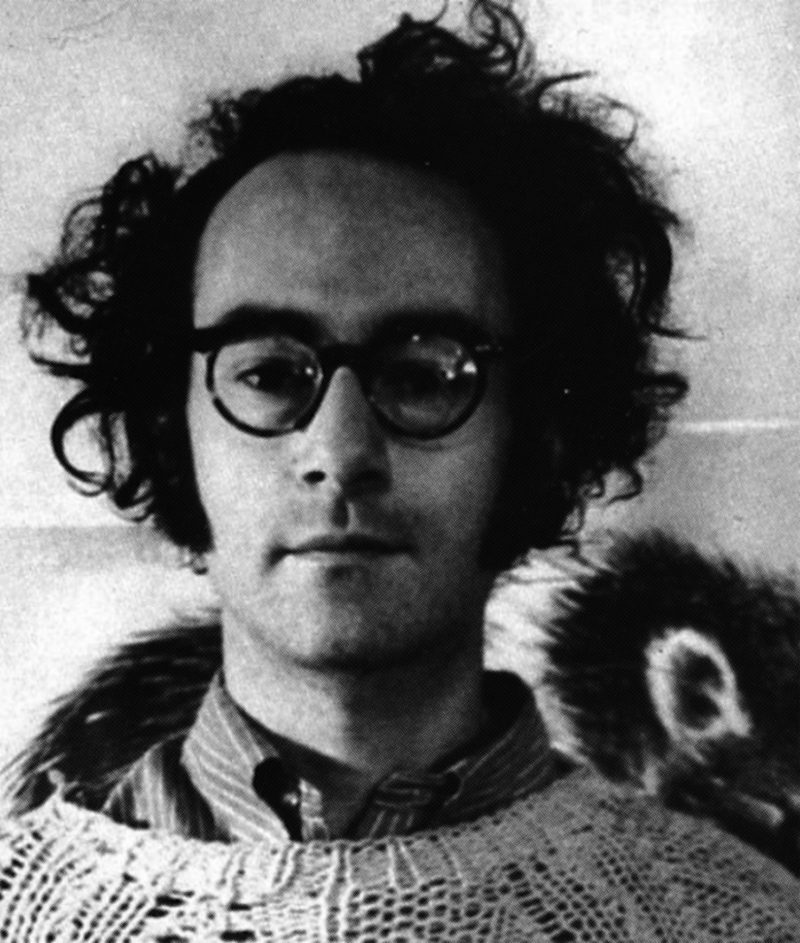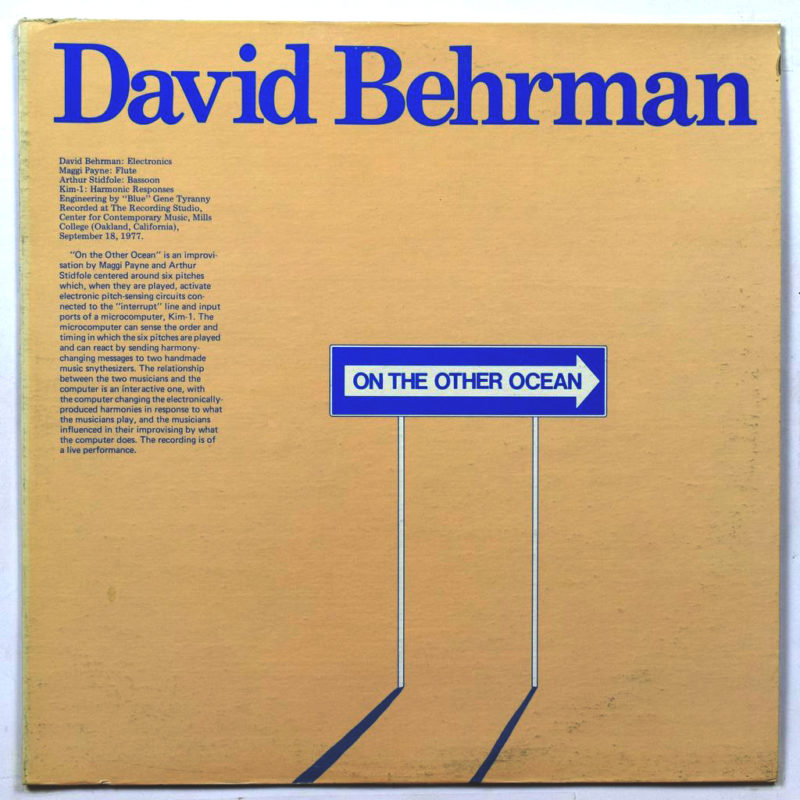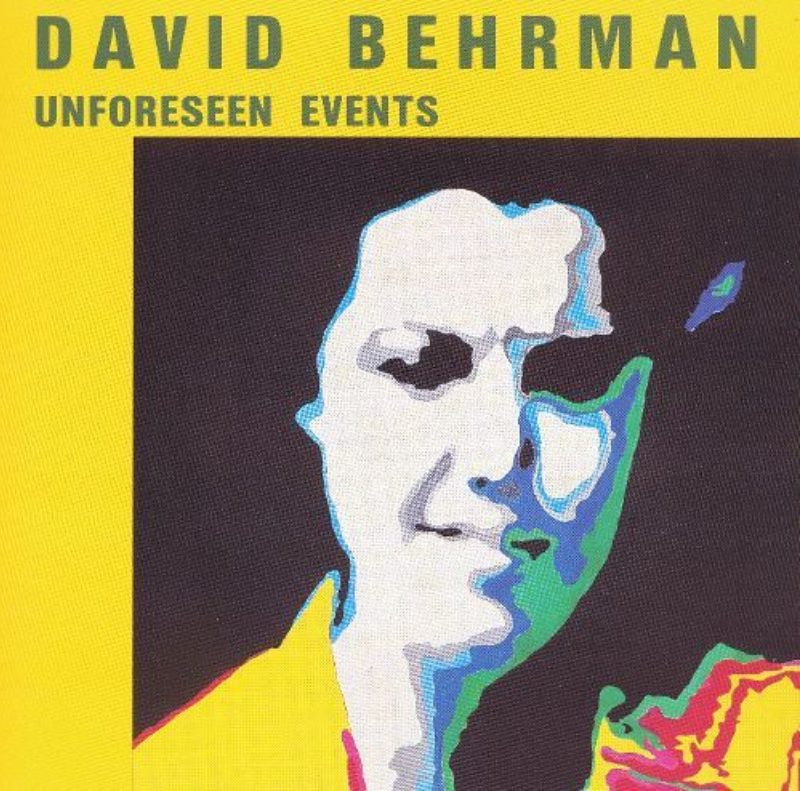David Behrman

David Behrman, born 1937 to American parents in Austria, was friends with Frederic Rzewski and Christian Wolff during his Harvard days. In 1959 he studied with Karlheinz Stockhausen. In the 60’s he started working as a producer for Columbia Masterworks on the influential Music Of Our Time series. During the 70’s he was composer / performer for the influential Merce Cunningham Dance Company and was a regular assistant for John Cage. In 1959 he shortly lived in Brussels, working as an assistant for Henri Pousseur and later made brief visits to the Pousseur family in the early Sixties. This relationship with Pousseur resulted among other things in a composition called Ricercar, composed in New York in 1960-61. In Brussels he would sometimes visit the Spanish Restaurant where artists went after concerts organised by Pousseur tohave cheap food and litres of wine, and where Steve Reich got his inspiration for clapping music when during eating and alcohol marinating he was watching the flamenco dancers entertaining the restaurant guests.
American composer Philip Corner collaborated various times with David Behrman and mentions him as “the guy always wrapped in cables and wires”. Japanese pianist Haruna Miyake describes Behrman’s work as “an oeuvre of unfinished composi- tions”. Jacques Bekaert mentions him as “one of the few Americans that eat with both fork and knife”. And Alvin Lucier praises Behrman for grandly steering away from the oppressive standard one comes across while playing the field of interaction and improvisation, the direct call and response idea. But more about this later...
In a career now spanning almost 60 years, Behrman’s oeuvre of multi-media installations, compositions, performances, gallery works, production et al spans a broad spectrum. From Canons, a piece for piano and percussion dating from 1959 composed during Karlheinz Stockhausen’s composition class at Darmstadt, to his meditative On The Other Ocean, used by aforementioned Bekaert as a “stress relief tape” when he was traveling as a journalist through troubled conflict areas. To the little-known yet amusing pop pastiches of She’s-A-Wild, a band with Paul DeMarinis, Terri Hanlon, Fern Friedman and Anne Klingensmith. From his politically inspired works My Dear Siegfried (2005) and A New Team Takes Over (1969), to his very contemporary and fresh sounding A Traveller’s Dream Journal (1988-1990) on which he collaborated with German Krautrock figures Clara Mondshine and Jakino.

The red thread in this diverse yet unambiguous and unique oeuvre is his use of flexible structures and the use of technology in personal ways, and a clear emphasis on interactive realtime relationships with (imaginative) performers. Furthermore Behrman sports an outstanding feel for beautiful harmonics, which is even present in his more abstract or more abrasive works. Many times these harmonies are presented as pure distilled synthesized sounds — simple frequency modulations, simple vibratos, basic square waves — which at first misleadingly may sound very easy, but with every hearing transform into deeper meanings. This aesthetic quality makes listening to his music a pure joy, both on the first, the second and the umpteenth turn, a special quality that is not always met in the hermetic academic world. Maybe Behrman adhered this attention for harmonics and listen-ing joy during his years working as a producer for Columbia Masterworks? Behrman’s peers Joel Chadabe, Paul DeMarinis, et al; and his fellow Sonic Arts Union members Robert Ashley, Alvin Lucier and Gordon Mumma all underwent a parallel growth from a more classic, conceptual academic lingo to a more personal and unique pallet of colours and idiosyncratic styles. Outgrowing a limiting and dry conceptualism, reacting against an all too classical, sometimes even Eurocentric intellectual environment, over the decades building up a new vocabulary that can be interpreted as modern day Americana.
Behrman is usually tagged a minimalist composer. As one could already learn from this all too brief primer, this is a label that does him short. Yet semantic discussions and academic meanderings about styles and theories is something I’m sure Behrman isn’t spending too much of his time on. Instead his whole career focuses more on the practical; on intentional interaction with humans either or with machines. Alvin Lucier mentions in his Music 109 book, that Behrman’s “main and firm belief is in the artistic strength of the interaction”.
It is always tedious when a slightly young man as myself starts to criticize the current day artistic use of technology and music scoring, holding it against the light of good examples from the past. Though it occurs to me that for instance a current more sensationalistic use of softand hardware is a nuisance to a serious creation of modern music. Many a time one goes lightheaded about creating a bleep and a stutter here and there, blurring the purpose except and only for the final result to be very sensational, simply eventful and oddly mimetic. This is an almost record collector approach I dislike and I seriously consider a nuisance for a further development of a new canon of music. I wouldn’t go too much in depth on this, but just with studying Behrman’s use of hardand software, his constant updating and reconfiguring, his emphasis on the interaction and creatively applying the effect, I noticed that in his very own world, the dialogue with techniques sprouts from a necessity of clear meanings and intentional composition. Out of his interest in the interaction he found a path to make his music more deliberate, challenging and above all more humane and personal. In his words, he decided to stop asking favours to ensemble players et al, and decided to built tools to create a more precise sound world. Yet I guess nowadays those favours are asked a lot by my peers and young musicians exactly to those ensemble players, or more correctly to companies like Doepfer, Yamaha, Elektron and alike, and on a larger scale to the overtly present references and influences. To a point where one considers all those tools and data as being more important than the actual composer, the actual self. It’s almost that the person is merely there to fulfill the machines’ and the references’ favours. It makes one wonder... Because if we keep our thoughts and dedication merely to just these predefined concepts and processes, and if we just run with it and use certain tools as mere gadgets; our music eventually will stop growing.
Anyway, this discussion could go on for pretty long, since there are various sides to this story. So let’s focus on Behrman again, and let us look at some of his pieces a bit closer. I’ve hand- picked five of his compositions regardless of their importance or critical assessment, using them as a map to a diverse yet unified creative world.
A piece for prepared piano composed after Behrman had returned to New York following a year in Europe. It has the flexible form back then very much favoured by European composers, and also reflects the work of Henry Cowell and John Cage. Behrman developed a changeable score using heavy paper and posterboard to spring various exe- cutional possibilities for the performer. It’s safe to say that this technique preceded his later use of hard- and soft- ware to insert (un)deliberate changes.
Sounds For A Film By Robert Watts (1968)
This is a personal favourite of mine. It’s a heart-breaking simple juxtaposition of field recordings, ukulele strumming and sparse electronic sound, recorded at Stony Point where back then there was an artist colony frequented by David Tudor, John Cage, Stan Vanderbeek, et al. Around the same time, two other favourite composers of mine, Jacques Bekaert (A Summer Day At Stony Point, and Mon Petit Album) and “Blue” Gene Tyranny (Country Boy Country Dog) made similar compositions. Bekaert even collected his field recordings at the same spot, Stony Point. Or maybe just used Behrman’s recordings, since they sound very similar to each other. For the full record, Behrman performs electronics on those two mentioned Bekaert’s pieces.
Field recordings were another way for the artist to find new meaning in sound, towards a new way of interaction. Or how Tyranny explains it, “to discover music in the sounds of daily life and to connect what was going on outside in connection to involuntary activity and imagination inside, creating a music of its own”. This new modus was of course facilitated by a mass-market introduction of affordable portable tape players. Nowadays this trick has been and is still being done quite a bit. But it’s almost uncanny how effective this simple style of observation and juxtaposition still can be. Maybe it’s because it involves the reconfiguration of a multi-dimensional sound world into a mono either stereo wave, thus triggering excitement in the brain nonetheless.
In the construction of their pieces, Behrman, Tyranny and Bekaert all shared a love for the more regular and normal sounding sounds of nature and daily life. It was a few decades before the modern field recordist started to put together funding files to fly out to the Antarctic and throwing an expensive microphone in an iceberg. Or before field recordists travel far away to record almost extinct animals, making a valid addition to their imminent extinction.
A New Team Takes Over (1969)
Just like most of his peers, Behrman sported a political awareness and sometimes felt a natural urge to clearly illustrate this in his works. A new team... is a rough and alienating performance work based on recordings of press conferences and speeches by the Nixon administration. These recordings were distorted using a few handmade synthesizer modules while performers would mimic the politicians, and mannequin dolls by the artist Sari Dienes with the heads replaced by loudspeakers were placed in the audience. A New Team... is a beauty of disagreeing and distress, something that for instance Paul DeMarinis also applied in a few of his own works.
A Traveller’s Dream Journal (1988-1990)
This is an example of all-over music. Many of the elements are present during most of the piece yet there’s still a clear direction in the composition, a style Behrman used a lot in many of his works.
At first A Traveller’s Dream... sounds like a collection of ring tones; and DX7, and General Midi pad and percussive presets, yet it gradually evolves into a beautiful and otherworldly serenade. This was only the second piece I’ve listened to after getting to know about Behrman’s music through his On The Other Ocean classic, and it still remains one of my favourites. For me it raised many questions on how a modern composition can be since this composition sounds, with all due respect, almost cheesy in tonal colours and harmonics, yet at the same time it has so much depth, originality and intellectual content. Speaking for my own music, things have never been the same since then...
The first version I owned was a download from Soulseek so later I was happily surprised to realise, while reading the liner notes in the actual CD edition, that this is in fact a collaboration with Walter Bachauer aka Clara Mondshine. About fifteen years ago, Bachauer’s rhythmic Kraut tunes would regularly accompany me on the Walkman while walking to university. This composition is another fine example of Behrman’s lust for interaction, since it’s very clear that the dialogue with Bachauer makes the piece’ general atmosphere a bit different — rhythmic structures, melody clusters, ... — but not all too different.
Unforeseen Events (1991)
Unforeseen Events is a grand collection of software-based music and ideas. I think I should call it Behrman’s Magnum Opus since the collection feels like an anthology of his technical and creative pallet.
As far as I know, it is the first time that he himself refers to his compositions as being unfinished, a term suggested by Haruna Miyake earlier (see above). With calling his music unfinished, he means “in the sense that it has a character and a form, which are recognizable no matter who performs it, and it is unfinished in the sense that it takes an imaginative and expert musician to pilot it up off the runway and into the air”. Here Behrman indulges fully in his lust for “performer freedom”. In a reality where there’s still daily discussions about if the performer should be granted maximum freedom to execute a piece or on the contrary should be tightly follow instructions, Behrman chooses the first option. In the liner notes of the CD edition of Unforeseen Events, Behrman praises the luck he had with dealing with this freedom and the array of pleasant surprises it brought him. Later, in relation to another composition, Behrman mentions the following: “Today I was listening to a recording that Maggi Payne just sent to me of a piece we worked on recently called QSRL. She performs the flute (which one normally thinks of as a gentle instrument) in a very strong and sometimes harsh way, making the electronics (which one might normally think of as mechanical and a bit macho) seem sinuous and yielding and gentle. I never in a million years could have imagined this relationship; I felt really happy that the situation was left open enough so that such a thing could occur.”
Unforeseen Events consists of four parts, maximally using pitch-to-midi and related techniques that create a set of tones, pitch changes, new note lengths, velocity changes et al; creating layers of sound around the trumpet of Ben Neill, a regular collaborator of Behrman. As already mentioned above, in this and many other of his works, Behrman beautifully gets rid of the oppressive direct cause and effect. Most of the software interventions do not always create an imminent perceptible result. Alvin Lucier describes it aptly, “as you listen to Behrman’s pieces you only get glimmers of directness; most of the time the relationships are interrupted and distant and therefore engage the listener in tantalizing ways”.
